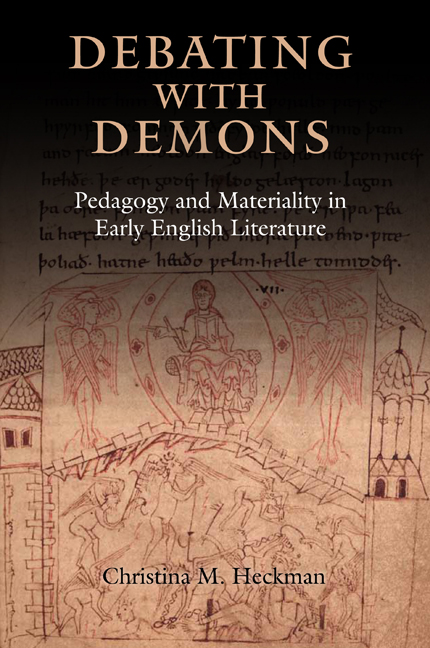Book contents
- Frotmatter
- Dedication
- Contents
- Introduction: The Devil’s Secret Chamber
- Part I Foundations
- 1 Spirituo-Materiality in the Early Middle Ages
- 2 The Artes Liberales in the Early Middle Ages
- 3 The Devil Within: Perils of Pedagogy in the Monastic School
- Part II The Demonic Magister in Early English Poetry
- 4 The Origin of the Teaching Demon: Lucifer as Magister
- 5 Demonic Teaching and the Fall in the Old English Genesis
- 6 Demonic Teaching and Saintly Discretio in Cynewulf’s Juliana
- 7 Inventing Materia: The True Cross and Saintly Disputation in Cynewulf’s Elene
- Conclusion: The Mysteries of Pedagogy
- Bibliography
- Index
- Acknowledgments
- Anglo-Saxon Studies
Conclusion: The Mysteries of Pedagogy
Published online by Cambridge University Press: 06 October 2020
- Frotmatter
- Dedication
- Contents
- Introduction: The Devil’s Secret Chamber
- Part I Foundations
- 1 Spirituo-Materiality in the Early Middle Ages
- 2 The Artes Liberales in the Early Middle Ages
- 3 The Devil Within: Perils of Pedagogy in the Monastic School
- Part II The Demonic Magister in Early English Poetry
- 4 The Origin of the Teaching Demon: Lucifer as Magister
- 5 Demonic Teaching and the Fall in the Old English Genesis
- 6 Demonic Teaching and Saintly Discretio in Cynewulf’s Juliana
- 7 Inventing Materia: The True Cross and Saintly Disputation in Cynewulf’s Elene
- Conclusion: The Mysteries of Pedagogy
- Bibliography
- Index
- Acknowledgments
- Anglo-Saxon Studies
Summary
The primary texts examined in this book, from hagiographical poems to school-texts, assert unequivocally the material reality beyond the textual. This reality is not merely metaphorical; it is thoroughly integrated with bodies and places, manifesting a ‘thing-ness’ that will not be denied. Recognizing the role of materia in meaning-making is fundamental to understanding these texts. Both the texts and the materia related to them participate in ongoing debates about the relationships between knowledge and being, debates in which demonic figures, through magisterial deception and disruption, have prominent voices, deploying their seductive informal logic in dialogue with their ‘pupils.’ The verbal arts of rhetoric and dialectic, which underlie this informal logic and are essential for debating and preaching about onto-epistemological matters, are also unstable and can be used to deceive as well as to reveal and argue for truth. And the demons who use these linguistic arts so cleverly can occupy both poetic ‘places,’ long ago and far away, but also, apparently, the monastery down the road. Demonic threats lurk wherever teaching and learning take place, making pedagogy a dangerous art indeed. The only perfect lessons are bestowed by Christ, and secondarily by the apostles and many – though seemingly not all – of the saints. The teaching of demons, however, can often be more immediately compelling and convincing than righteous teaching, destabilizing even divine and saintly instruction.
Poetic dialogues with demonic teachers illustrate the problem of what happens when geong ones, pre- or post-lapsarian, are left to themselves to discern the truth. These pupils often make mistakes, because that is how one learns. Furthermore, such mistakes are essential to faith, according to MacKendrick, indicating ‘a constant and necessary openness to question, a willingness to dwell in questioning, in mystery – and so in a sense of the sacred, as the complication of the world by divinity.’ Such openness, however, can have ontological consequences, potentially leading geong questioners into danger. Teachers want their pupils to be attentive, curious, and engaged – but not too much, and not about the wrong things. While the discretio of a saint like Juliana provides protection, other saints, like Judas Cyriacus and Elene, are torn by competing interests and easily distracted from the task of pursuing knowledge and truth.
- Type
- Chapter
- Information
- Debating with DemonsPedagogy and Materiality in Early English Literature, pp. 205 - 211Publisher: Boydell & BrewerPrint publication year: 2020

